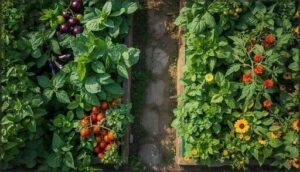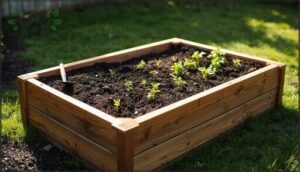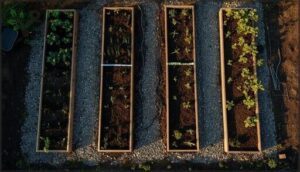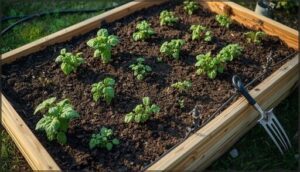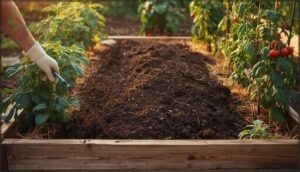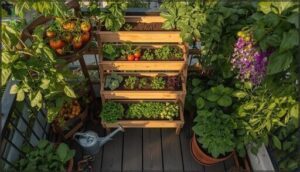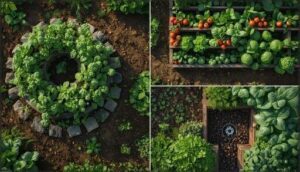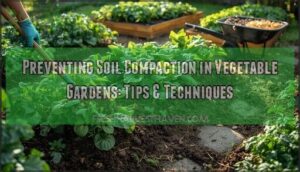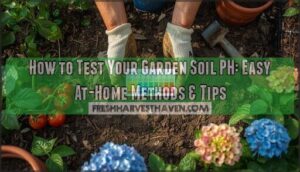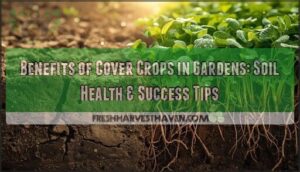This site is supported by our readers. We may earn a commission, at no cost to you, if you purchase through links.
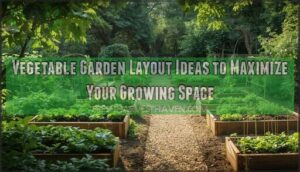
The difference between a struggling patch of vegetables and a thriving garden that feeds your family for months often comes down to one thing: a smart layout that works with your space instead of against it.
Whether you’re working with a sprawling backyard or a tiny balcony, the right vegetable garden layout ideas can transform how much food you grow, how easily you maintain it, and how long your harvest season lasts.
Table Of Contents
- Key Takeaways
- Garden Layout Basics
- Choosing Garden Plants
- Raised Garden Bed Ideas
- Small Space Gardening Tips
- Unique Garden Designs
- Frequently Asked Questions (FAQs)
- How do you design a vegetable garden?
- What is a vegetable garden layout?
- How to create a simple plan for veggie gardening?
- Which vegetables grow well together chart?
- Which vegetables should not be planted next to each other?
- What is the best path for a vegetable garden?
- Which vegetables should be planted together?
- How do I map my vegetable garden?
- What vegetables should not be planted next to each other?
- How do I layout my vegetable garden?
- Conclusion
Key Takeaways
- Smart garden layouts like square foot gardening and raised beds can multiply your harvest by up to 7 times while slashing water use by 90%, proving that strategic planning beats traditional row planting every time.
- Companion planting transforms your vegetable garden into a self-defending ecosystem where strategic pairings like marigolds with tomatoes cut pest pressure by up to 50% and beans with corn boost yields by 13% through natural nitrogen fixing.
- Vertical gardening techniques and container systems reclaim up to 75% more growing space in small yards and balconies, letting you harvest 20 times more plants per square foot when you stack crops upward instead of outward.
- Climate-smart crop selection matters more than space size—matching vegetables to your weather conditions and frost dates increases yields by 22% while reducing crop failure from temperature stress and disease pressure.
Garden Layout Basics
Breaking free from traditional row planting opens up a world of smart, space-savvy layouts that’ll transform even the smallest plot into a productive garden. Whether you’re working with a tiny backyard or carving out a dedicated kitchen garden, the right layout puts you in control of your growing space.
Let’s look at four proven methods that optimize your harvest without maxing out your square footage.
Square Foot Gardening Methods
Square foot gardening breaks free from conventional rows—imagine your 4×4-foot bed carved into 16 one-foot squares, each hosting different crops. This grid planning powerhouse delivers up to 7 times the harvest while slashing water use by 90%. Here’s your rebellion against wasted space:
Square foot gardening transforms a 4×4-foot bed into 16 productive squares, delivering up to 7 times the harvest while slashing water use by 90%
- Mix one-third vermiculite, one-third peat moss, and one-third compost for ideal soil mixtures
- Plant densely—up to 16 carrots per square
- Rotate crops between squares for natural pest control
Add vertical gardening techniques with trellises, and you’ll transform small space gardening into a productive powerhouse. By using intensive gardening methods, gardeners can boost their yield in limited spaces.
Raised Bed Gardening Layouts
Once you’ve mastered square foot gardening, take command of your space with raised bed gardening layouts.
Build beds 4×4 or 4×8 feet for bed size optimization—wide enough for crop yield maximization but narrow enough for gardener accessibility. Fill them 12-18 inches deep with a 70% soil, 30% compost mix for killer soil management.
Choose raised bed materials like untreated wood or stone, orient them north-south, and watch your vegetable garden layouts outperform traditional rows by 140-264%. Consider the importance of proper raised bed dimensions when planning your garden.
Backyard Garden Layouts
Your raised beds are dialed in—now tackle the full canvas with smart Backyard Gardening. For Garden Plot Optimization, carve out 600-800 square feet for a family of four, or start with 100 square feet if you’re breaking free from store-bought produce for the first time.
Use Yard Zoning Strategies: centralize your Vegetable Garden Layouts around a 2,000-square-foot hub, add L-shaped beds in shady side yards, and integrate Microclimate Design to boost Garden Accessibility. Space Saving Techniques and intentional layout turn even Small Gardens into abundant, liberating food sources.
Kitchen Garden Layouts
You’ve mapped out your backyard—now bring the harvest closer with a Kitchen Garden just steps from your door.
For Space Optimization and Yield Maximization, a 100-square-foot plot accommodates three to five varieties without overwhelming you.
Use Garden Mapping for Crop Rotation across four zones—roots, legumes, salads, mixed vegetables—and watch your Vegetable Garden Design deliver fresh, daily abundance with zero grocery store dependence.
Choosing Garden Plants
Choosing the right plants isn’t just about what you like to eat—it’s about understanding what thrives in your conditions and how plants work together. Your climate, available space, and planting combinations all shape what you can grow successfully.
Let’s break down the key factors that’ll help you pick plants that actually perform.
Selecting Vegetables for Climate
Your climate zone isn’t a cage—it’s your blueprint for climate resilience. Picking vegetables that match your weather means bigger harvests and less frustration. Lettuce and spinach varieties with heat tolerance boost yields by 22% when summer temps soar past 30°C, while tomatoes need protection when highs hit 35°C—pollen goes sterile fast.
- Cool-season champions: Broccoli, lettuce, and peas need 5–20°C soil temps and plant 4–6 weeks before your last frost
- Heat-loving heroes: Tomatoes and beans demand 18–29°C warmth—plant after frost danger passes
- Frost-date mastery: Warm-season crops lose 50% yield below 10°C; timing is everything
- Seasonal planning wins: Cool crops mature in 60–90 days; warm ones take 70–120 days depending on your zone
- Weather resistance matters: Short-season varieties at higher elevations finish before frost strikes
Smart crop rotation and sustainable gardening practices mean choosing varieties bred for your specific challenges. Vegetable gardening tips from landscape designers emphasize garden layout decisions that work with nature, not against it.
Your vegetable garden design should embrace these realities—that’s how you create a system with real weather resistance and long-term success in challenging environments.
Companion Planting Strategies
Strategic companion planting transforms your vegetable garden layout into a self-defending ecosystem. When you pair garlic or marigolds with your main crops, pest control happens naturally—border plantings slash pest movement by up to 42%. Intercropping methods boost both soil health and yields while crop rotation keeps diseases at bay.
- Marigolds with tomatoes suppress root-knot nematodes by over 50%
- Beans intercropped with corn fix nitrogen while increasing grain yield 13%
- Three Sisters polyculture benefits include reduced water loss and higher economic returns
Square foot gardening makes these vegetable gardening tips even more powerful in tight spaces.
Planting for Small Spaces
Don’t let a tiny plot hold you hostage. Compact planting methods like square foot garden layouts can squeeze up to 36 plants into one square meter—seriously. Dwarf tomatoes and baby carrots yield 20–40% more per square foot than standard varieties, while vertical gardening techniques reclaim up to 75% more usable space.
Container gardening slashes water usage by 30%, and succession planting cranks yield by 50%. Your small space gardening ideas just got bigger.
Vegetable Pairing Tips
Polyculture benefits crush monoculture every time—you’ll see a 32% yield boost just by breaking free from single-crop thinking. Companion planting transforms your vegetable garden layout into a self-defending ecosystem. Here’s how to dominate your square foot garden:
- Tomato-basil combos improve pest control methods and bump yields by 32%
- Corn-bean pairs drive soil enhancement through nitrogen-fixing, adding 13% more harvest
- Marigolds with zucchini cut pest pressure by 25%
- Strategic crop rotation and succession planting maintain nutrient uptake all season
Take control of your garden layout—pair smart, grow bold.
Raised Garden Bed Ideas
Raised beds give you total control over your growing conditions, which means you’re not stuck with whatever soil nature dealt you. They’re perfect if you want to break free from backyard limitations like compacted clay or poor drainage.
Here’s how to build, design, plant, and maintain beds that actually work for your space.
Building a Raised Garden Bed
You’re about to break free from the limits of ground-level planting. Building a raised bed puts you in control, and here’s where it all comes together:
- Raised Bed Materials—cedar or redwood last 10–20 years, while galvanized steel runs over 20. Choose frames that won’t quit on you.
- Soil Quality Management—blend compost with topsoil for drainage and nutrients your vegetable garden craves.
- Bed Construction Tips—aim for 8–12 inches deep and 4 feet wide for easy reach and solid garden design and planning.
Designing a Raised Garden Bed Layout
Your raised bed layout determines how much freedom you really have in that vegetable garden. Aim for 4-foot-wide beds—you’ll reach the center without stepping on precious soil. Keep pathways at 24–36 inches for easy tool access and corner navigation. Orient beds north–south for consistent sunlight.
Plan bed size optimization around 8×4 or 8×2 dimensions, with 8–12 inches of soil depth.
Factor in irrigation planning early—soaker hoses or drip lines integrate cleanly into your garden design and planning from day one.
Planting a Raised Garden Bed
Once your bed construction is dialed in, soil preparation becomes your secret weapon. Mix organic matter at 25–50% by volume, target pH between 6.2 and 6.8, and fill to at least 6–8 inches deep for strong root development.
Crop selection matters—tomatoes need 24–36 inches between plants, carrots just 1–2 inches. Install irrigation systems like drip lines before planting.
Smart spacing in your vegetable garden layout reduces disease and pushes yields 15% higher than conventional plots.
Maintaining Raised Garden Beds
Your raised bed won’t run itself—smart garden maintenance keeps those vegetables thriving year after year. Soil management means topdressing with compost annually since beds lose 2-4 inches from settling and plant uptake. Water 30% more often than ground plots, ideally at dawn or dusk. Here’s what separates serious growers from weekend warriors:
- Mulch with straw to crush 80% of weeds before they start
- Inspect weekly for aphids and fungal threats
- Check frames every spring—wood rots in 5-7 years
- Test soil every 2-3 years to dial in nutrients
Irrigation systems and pest prevention aren’t optional—they’re your insurance policy.
Small Space Gardening Tips
You don’t need acres of land to grow your own food—small spaces can be just as productive when you work smart. The key is choosing the right layout, picking compact varieties, and making every square inch count.
Here’s how to turn even the tiniest yard, balcony, or patio into a thriving vegetable garden.
Creating a Small Garden Layout
Think of your compact plot as a chess game—strategic crop placement wins. Start with garden mapping: measure your space, then sketch raised bed zones with 3-foot pathways for easy access. Orient beds north–south for consistent light.
Block planting beats traditional rows—you’ll gain 50% more yield by eliminating wasted walkways. Stack vertical frameworks along edges for climbers, freeing ground for leafy greens.
Prioritize soil preparation with nutrient-rich mixes since intensive spacing demands it. This layout planning approach transforms even tiny yards into productive vegetable gardening powerhouses, proving small space garden design is about smart space optimization, not size.
Choosing Vegetables for Small Gardens
Your space optimization strategy now needs the right crop picks. Compact Crops and High Yield stars like tomatoes (scoring 9/10 efficiency), leaf lettuce, and pole beans deliver serious harvests without sprawling. Space Savers such as ‘Tiny Tim’ tomatoes or ‘Bush Blue Lake’ beans thrive in your Container Gardening Ideas setup. Quick growers like radishes (harvest in 21 days) enable Crop Rotation magic, turning your Small Space Garden into a nonstop production line for Vegetable Gardening for Beginners.
- Prioritize tomatoes on stakes—they score 9 out of 10 for space efficiency
- Plant quick-turn crops like radishes (21–28 days) and lettuce (28–55 days)
- Choose dwarf varieties such as ‘Spacemaster 80’ cucumbers and ‘Tom Thumb’ peas
- Opt for multi-purpose vegetables like beets (edible greens and roots)
- Use 5-gallon containers for maximum yields from Roma tomatoes and peppers
Vertical Gardening Techniques
Vertical farming pushes your harvests skyward and can increase yield up to 13.8 times in tight quarters. These space-saving moves liberate every inch.
Garden towers hold 50–60 plants each—perfect for hydroponic systems or urban agriculture experiments. Living walls and raised beds merge function with flair, while window boxes and trellises tackle gardening in challenging environments.
| Method | Best Crops | Yield Boost |
|---|---|---|
| Garden Towers | Lettuce, herbs, strawberries | 50–60 plants per tower |
| Trellises | Peas, beans, cucumbers | 20× more plants/sq ft |
| Hydroponic Systems | Tomatoes, peppers, greens | Up to 13.8× higher yield |
| Window Boxes | Herbs, radishes, compact greens | Maximizes unused ledges |
Container Gardening Options
Containers break the rules of traditional ground plots and let you reclaim patios, balconies, and rooftops for real food production. Container size drives success—tomatoes demand 5-gallon pots, while herbs flourish in 4-inch window boxes.
Use soil mixtures rich in compost and perlite for drainage, then position containers where they’ll catch 6–8 hours of sun. Pair raised beds with vertical systems and gardening tools to maximize space.
Container and vertical gardening turn any surface into a productive plot.
Unique Garden Designs
Break away from boring rows and flat beds—your garden doesn’t have to follow the rules. When you’re ready to push boundaries and make the most of unconventional spaces, these creative approaches open up entirely new growing possibilities.
Let’s explore four designs that’ll transform how you think about garden layout.
Creating a Vertical Garden
Your walls aren’t just barriers—they’re untapped growing territory. Vertical gardening lets you break free from ground-level limits using trellises, hanging baskets, and hydroponics systems that stack plants skyward.
Choose sturdy wooden or metal panels for climbing crops like cucumbers and beans. These space-saving techniques can multiply your yield per square foot dramatically, transforming tight urban yards into productive green walls that deliver real harvests without claiming precious ground space.
Building a Potager Garden
Break free from ordinary rows—potager gardens transform vegetables into living art. This symmetrical Kitchen Garden design places a focal point at the center, surrounded by structured beds that blend edible crops with flowers and herbs. You’ll want 4-foot-wide Raised Beds with 3-foot pathways for easy access, combining smart Pathway Planning with layered Soil Management for vibrant, productive beauty.
Your potager garden blueprint:
- Claim your space with a 40′ x 40′ symmetrical Vegetable Garden Layout that puts you in complete control
- Layer your beds using the lasagna method—native soil, compost, and mulch stacked for explosive growth
- Plant boldly with 15+ species intermixed, pairing marigolds with tomatoes to slash pests by 30–60%
- Build upward using trellises and obelisks for Vertical Gardening that expands capacity by 20–30%
- Harvest endlessly through succession planting that keeps your Potager Garden producing year-round
Designing a Fenced Garden
A sturdy fence turns your Vegetable Garden into a protected powerhouse. By 2025, layered Fence Layout Designs combining low picket with taller panels surged 21%, giving you privacy and Wildlife Exclusion Methods that block 96% of deer and rabbits. The right Garden Security Tips slash pest damage by up to 82%.
Your fenced fortress blueprint:
- Choose Fence Material Options—wood ($10–14/ft), vinyl ($25–45/ft), or aluminum for rust-proof strength
- Add Vertical Planters or trellises to fencing, boosting climbing crop yields by 17%
- Seal gaps and check perimeter integrity yearly to maintain your Raised Bed sanctuary
Creating a Hanging Pot Garden
Your vegetable garden can climb when ground space runs out. Hanging Pot Systems release vertical gardening magic—utilizing walls, fences, and railings to extend urban gardening area by 45%.
Choose containers with 6-inch soil depth for herbs, cherry tomatoes, and greens. Daily watering and biweekly feeding keep container gardens thriving.
Mix window boxes with hanging pots for a layered garden layout that turns any balcony into productive space.
Frequently Asked Questions (FAQs)
How do you design a vegetable garden?
Think rows are the only way? They’re not. You design a garden by plotting sunlight first, then choosing raised beds or block layouts that boost airflow, simplify watering, and multiply your harvest per square foot.
What is a vegetable garden layout?
Your garden layout is the blueprint that shows where each crop lives. It’s how you arrange beds, rows, and spacing to capture sunlight, promote airflow, and make maintenance a breeze—not a burden.
How to create a simple plan for veggie gardening?
Before you sketch a single bed, map your sunlight patterns and measure your garden space.
Jot down veggie selections, group by height, then carve out pathways—future-you’ll thank you for easy access.
Which vegetables grow well together chart?
Pair tomatoes with basil to repel hornworms naturally. Combine carrots and onions to confuse pests. Companion planting creates your own pest control system.
Try the Three Sisters—corn, beans, and squash—for nitrogen fixation and weed suppression.
Which vegetables should not be planted next to each other?
Keep beans away from onions—they battle for the same nutrients. Tomatoes and potatoes share disease risks, while fennel’s allelopathy effects inhibit growth nearby.
Smart companion planting means avoiding these incompatible pairs for healthier yields.
What is the best path for a vegetable garden?
Like arteries feeding a living system, smart paths make or break your Garden Layout. Choose gravel, mulch, or stepping stones at 2–3 feet wide for Garden Accessibility and Ergonomic Design, reducing Soil Compaction while keeping your Vegetable Garden mud-free and productive.
Which vegetables should be planted together?
Smart companion planting transforms your garden layout. Beans fix nitrogen for corn, basil enhances tomato flavor and pest resistance, while marigolds slash aphid populations by half.
Rotate crops annually—your soil health and yields will thank you.
How do I map my vegetable garden?
Draw your garden layout to scale, marking sunlight patterns and water sources.
Group vegetables by height and needs through strategic spatial design, then plan pathways wide enough for comfortable harvest access and crop rotation.
What vegetables should not be planted next to each other?
Good fences make good neighbors—especially in your vegetable garden. Tomatoes and corn wrestle for nutrients, while onions stunt bean growth. Separate potatoes from squash to sidestep pests.
Strategic companion planting and crop rotation prevent these allelopathy effects.
How do I layout my vegetable garden?
Start your garden layout by grouping plants by height—tallest on the north side to prevent shading.
Place quick-harvest crops near pathways for easy access, and use companion planting to naturally boost soil health and deter pests.
Conclusion
Think of your garden like a chess board—every square matters, and the right moves multiply your results. That extra hour you spend sketching your vegetable garden layout ideas before planting season? It’s the difference between harvesting baskets of tomatoes or watching them choke each other out by July.
Your space doesn’t limit what you can grow. Your layout does. So grab some graph paper and start designing your most productive garden yet.
- https://northerngardener.org/maximize-veggie-garden-production/
- https://ngb.org/raised-bed-gardening-benefits/
- https://www.thespruce.com/companion-planting-with-chart-5025124
- https://www.gardeners.com/how-to/small-space-vegetable-garden/8766.html
- https://ucanr.edu/statewide-program/uc-master-gardener-program/efficient-use-space

